Winemaking Classes Are BACK!!
Hey Guys!
As Wine Grape Season approaches we are starting to brush up on our winemaking skills. Below is our NEW Schedule of Winemaking Classes. Please contact Christina Musto via phone (877.812.1137) or email (cmusto@juicegrape.com) or sign up online!
We hope to see you there!
The only hands-on winemaking bootcamp in the area. No need to spend thousands. M&M Wine Grape Company is pleased to announce the start of a ten week class for beginner winemakers in the art and science of making wines. This course offers each student the opportunity of experiencing hands-on winemaking and producing their own five gallons of wine by the end of the semester. In addition to actually making wines, the course will cover the science behind modern wine making and fermentation techniques including additives commonly used by commercial wineries throughout the wine making world. Classes will be about 3 hours each Saturday afternoon, starting at 1:00 pm, in the offices and winemaking showrooms of M&M Winegrape Co, 101 Reserve Road, Hartford, Ct, 06118.
We are currently accepting enrollment for this 10 week course with lecture and hands-on labs. The cost is $300/student plus the cost of grapes for the 5 gallon batch.
The next class will start August 29th 2015
Click here for more information about the course.
This program primarily covers the basics necessary to understand the art and science of making wine. Students should leave the class with an overview of the winemaking process and prepared for a hands-on experience.
The entire spectrum of the process is addressed including cleaning, sanitizing, and preparing equipment, understanding and performing appropriate metrics, detailed steps needed to produce finished wine from fresh grapes, grape juice, frozen musts, and kits, bottling and storing wines. Discussions include equipment choices from manual to electric units, wooden barrels for storage, stabilizing and preserving wines for extended time, and other pertinent tops. The class consists on one three plus hour slide presentation/lecture with open Q&A, and tasting examples of home made wines. Students must be at least 21 years of age to participate in wine tasting/evaluation exercises.
COURSE OBJECTIVES:
- Introduce the basic practices of wine making.
- Provide an understanding and feel for the skills required to successfully make high quality wines.
- Introduce the student to the sanitary requirements necessary to consistently produce world-class wines.
We are currently accepting enrollment for this course. The cost is $49.95/student.
The next class will start TBD
Click here for more information about the course.
This program primarily covers laboratory skills needed in the art and science of making wine. This course compliments and should be taken after having taken the Intro to Wine Making (EDUIWM101) course.
In order to consistently make high quality wines the winemaker must perform a number of tests and functions to monitor and adjust the progress of the fermentation and aging process. This class discusses and demonstrates a number of such functions including acid titration, pH, sugar content, fining, etc., including alternate methodologies for sugar and acid titrations. Students must be at least 21 years of age to participate in wine tasting/evaluation exercises.
COURSE OBJECTIVES
- Introduce the basic laboratory practices of wine making.
- Provide an understanding and feel for the skills required to successfully measure fermentation progress.
We are currently accepting enrollment for this course. The cost is $49.95/student.
The next class will start April 21st 2015
Click here for more information about the course.
This program covers the basics necessary to understand the art of wine tasting and evaluation. Students should leave the class with an overview of the winemaking process and how to evaluate wines with confidence.
COURSE OBJECTIVES
- Introduce the basics of sensory analysis pertaining to wine
- Provide an understanding and feel for the skills required to be a wine judge and/or sommelier.
Students must be at least 21 years of age to participate in wine tasting/evaluation exercises.
We are currently accepting enrollment for this course. The cost is $39.95/student.
The next class is TBD
Click here for more information about the course.
Winter at Cassidy Hill Vineyards
Winter time in the vineyard is very important. What happens at the beginning of the year sets the tone for the vintage to come. Cassidy Hill Vineyards in Coventry, CT was kind enough to send us some photos of what is going on in their vineyard this winter. As you can see there is a lot of snow but once the snow melts they will get back to pruning. It looks like it’s their vineyard dog’s favorite activity, don’t you think? 🙂 Notice the close up pictures of the vines. There is an example of a non-pruned vine and what the vine looks like after they went through and pruned.
Pruning can be a very tedious task. The grapes are only harvested off of 2nd year wood. Therefore, off of each spur you prune down to one cane. Off of each cane you prune down to two buds and each bud will grow into a new cane. Each cane will then have 2 clusters. It sounds simple enough but many vineyard managers will tell you it can be difficult and time consuming. The next time you drive by your local vineyard take a look at what stage of life the grapes are in. Are they dormant? Have the vines been pruned? Do you see bud break? Just because it isn’t harvest, doesn’t mean there isn’t work to be done in the vineyard.
Bring on the Bordeaux! – A Home Wine Making Experience (6)
And we are ready to go! First, we need to sanitize the press. We don’t want any gross microbes to get into our fabulous wine. Second, we shrink wrap the press to make sure the juice doesn’t squirt out at us. Third, we transfer the must into the press and let the press do it’s thing. Finally, we transfer the juice from the press to the stainless steel tank where we will be aging the wine until we decide to barrel age or add more oak additives.
You can see all the tubes attached to the press above. This is because we decided to use a bladder press. Bladder press’s are easy to use and don’t press the must too much. If you press too hard you run the risk of breaking the seeds and releasing astringent flavors. The bladder press has a happy medium of extracting optimal juice while maintaining the quality of the juice.


And now we wait… Thanks again for stopping by. Next time we will rack our wine. Stay tuned!
Side Note: Don’t Press in November, It’s Cold!!!!
Winter in the Vineyard
This gallery contains 3 photos.
Right now the vines are dormat and enjoying a little sleep. If you drive through the vineyard areas you will see different types of grass and flowers growing in between the rows. These plants are not randomly growing in the rows. They were planted there for a reason (and no it’s not just because they look pretty). These plants are called cover crops.
Cover crops help protect and enrich the soil in a variety of ways. They help regulate vine growth, protect soil from erosion, improve soil fertility, draw away the abundant moisture, help with air quality, and introduce beneficial insects to the soil and vine.
The photos you see above are from Lanza-Musto Vineyards. At Lanza-Musto Vineyards we planted three peas, crimson clover, mustard, and oat throughout the rows. These are all full of nitrogen and other nutrients. Some rows have more crops planted than others. For example, the younger vines have the three peas mix because the younger vines need more nutrients. Where as an older vineyard might have a mustard mix.It is important to remember that vineyard maintenance does not start and end at harvest time. There are many things that need to be done in the vineyard throughout the year to ensure the vines produce quality fruit.
Our Winemaking Resolutions for 2015 – What Are Yours?
This gallery contains 1 photo.
Happy New Year Winemakers!
Frank:
- To improve my personal winemaking skills and winemaking knowledge
- To continue to grow my friendships and business relationships within the wine industr
- To visit more wineries and winemaking groups
Nick:
- My resolution is to continue to find ways to enjoy winemaking and the business we are in. Whether it is helping someone just starting out in making wine or someone starting a winery. The passion we bring to this business is not something that can be imitated.
Kim:
- I would like to start trying more locally made wines
- I too need to stop procrastinating on racking, etc…
- I would like to work on expanding my pallet! (sometimes I think it’s broken lol)
Frankie K: I have a couple!
- I would like to drink more wine! (I really mean that, I often choose beer when wine is available and would like to stop doing that. Beer has a ton of calories!)
- I would like to procrastinate less in my wine racking and other exercises. I often find myself putting those things off because I am too busy, and the wine ends up suffering as a result.
- And I would also like to drink more wine!
Christina:
- To try more wines from the East Coast as well as wines from other countries
- To research new blends to try next vintage
- To make a sparkling wine for the first time
- To make Grapa for the first time
Ken:
- I would like increase my knowledge as it pertains to Malolactic Bacteria. When has my wine completely gone thru malo? When is the proper time to add sulfites?
- I would like to take classes in becoming a Certified Wine Competition Judge
James:
- Visit more local wineries
- Improve my winemaking lab skills
- Learn more about wine and food pairings; what kind of wine does go with a big mac?
Bring on the Bordeaux! – A Home Wine Making Experience (4)
This gallery contains 1 photo.
So 11/6 was a sad day. When we went to punch down the wine, there was an off odor. To be specific it smelled like rotten eggs. This means my yeast is “stressed”. UGH!!! I’ll admit I panicked a little. Why does this happen? Well there are multiple reasons. One is in the Vineyard. Sometimes the grapes are sprayed too close to the time of harvest and the copper or sulfur compounds will stay on the grape. Another, is the yeast can get stressed if there aren’t enough nutrients for them. Sometimes the grapes don’t have enough nutrients, and as winemakers we fail to properly introduce enough supplemental nutrients for the yeast to complete fermentation.
Thankfully, there are multiple ways to treat this issue.
- You can aerate or “rack and splash” the must in order to “blow off” the smell. This will only work if the issue is lack of oxygen.
- You can add DAP. DAP stands for Diammonium Phosphate. It is a source of nitrogen (aka food for the yeast). Therefore, when you introduce DAP the yeast has more food to eat and the odor disappears.
- After fermentation, you can run the wine over copper. The copper will absorb the sulfite and help eliminate the odor. However, it will strip the wine of some flavors.
- You can add Reduless after fermentation. Reduless will not strip the wine like copper and it will remove the smell if it is a h2s issue.
We chose option 2 and it worked! We introduced 100 grams of DAP to the wine and in 2 days the off odor was gone.
Once we were able to get rid of the odor we added a 1/2lb of French oak dust. This addition helps protect against oxidation and increase color stability. The next time we will introduce oak to our wine will be during the aging process.
Thanks again for stopping by. Next time we will discuss Maloactic Fermentation.
Cheers ~ CM
Mulled Wine ~ Getting in the Holiday Spirit
This gallery contains 2 photos.
We hope everyone had a very Happy Thanksgiving. We have so much to be thankful for and it’s good to take a step back, reflect, and enjoy each others company.
Now that we are in the holiday spirit we have been experimenting with different winter wine recipes. One of them being Mulled Wine. Below is my recipe. I suggest pairing it with friends by the fireplace and a tasty charcuterie plate.
4 cups apple cider (or can use apple juice if you want it a little sweeter)
1 bottle of red wine (suggest cabernet, merlot, or a blend of both)
1 tablespoon – 1/4 cup of honey (depends on your sweet tooth)
2 cinnamon sticks
1 orange – juiced and zested
4 whole cloves
2-3 stars of anise (do to taste)
orange peels/wedges for garnish
Add the apple cider/juice, wine, cinnamon sticks, orange zest, orange juice, and cloves to a saucepan. Bring to a boil. Add stars of anise and honey to taste. Let it simmer for 8-10 minutes. Pour into mugs, add an orange peel/wedge for garnish, and enjoy!
Bring on the Bordeaux! – A Home Wine Making Experience (3)
It’s all in the yeast
We waited for our must to come up to a temperature of about 60 degrees and added our yeast starter, opti red, and tannin ft rouge. Below are our reasons for these additions.
Yeast occurs naturally on the skins of all wine grapes. If they are left alone, these yeasts will ferment the juice into wine. Some winemakers let the “wild” yeast ferment the juice. We however, use cultured yeasts. This is because we received grapes from multiple vineyards and the different strains of wild yeast will fight for the sugar or their “food”. This can cause the wine to not fully ferment and result in a stuck fermentation because of all the competition between yeasts.
The yeast we chose was FX10. We chose FX10 because it is a vigorous fermenter. It enhances the mouth feel to be big mid-palate with major fruit concentration. The wine will have notes of intense fruits while maintaing a soft, silky mouth feel.
To kick off pitching our cultured yeast we heated up a bowl of distilled water to 110 degrees. Dissolved a tablespoon of sugar in the water (the sugar helps the yeast go from a “freeze dried state” to a “living, wet state”). Added 72 grams of GoFerm. We let the GoFerm sit alone until the temperature was 104 degrees. Then we added the FX10 yeast. The whole process takes about 15 minutes. The bubbles in the photo below are proof that the yeast is awake and working.
Before we mixed our yeast starter in with our must, we added our opti red and tannin ft rouge (pictured below). The opti red helps extract more color from the skins. The tannin helps create a better mouth feel and more complexity in the wine. All you need to do to add this is dilute them in distilled water and mix into the must.
Below is a photo of us adding the yeast starter to the must. We took juice from the must and mixed into the yeast starter first. We did not just dump it in. In our opinion, it is better to try to make it all “one organism” instead of dumping into the must right away. It makes for a smoother start to fermentation. Once the additives and yeast were added we punched down the cap.
Now we monitor the must’s temperature, brix level, and smell. If there are any off odors we want to make sure to deal with them right away.
Thanks again for stopping by. Next time we will get into DAP and when to add oak additives.
Cheers ~ CM & FJ
Bring On The Bordeaux! – A Home Winemaking Experience (2)
So before we start going into how our wine is doing, we wanted to outline some winemaking terms. Here’s a mini wine vocabulary lesson.
Degrees Brix: Expresses the percentage of sugar by weight. This scale is on a Triple Scale Hydrometer. Measuring the Brix by using a hydrometer will help you determine the level of alcohol you wish to produce in your wine.
pH: This is the potential Hydrogen ion. The pH scale spans from 0, representing extreme acid, to 14, representing an extreme base or alkai. For winemaking purposes only the 0-7 scale is considered and wine should between 3-4. The more intense the wine acid is, (the lower the number) the less free sulfite is needed to afford proper protection and hence wine stability.
Total Acidity: This measurement refers to the amount of acid that is in your wine in grams/liter of percent of volume. Ideally, your TA should be between 0.65%-0.85% for white wine and 0.60%-0.80% for red wines. If the acid is too low your wine is susceptible to bacteria and spoilage. If it is too high your wine will taste too tart.
We took the must out of the cooler on 10/28 and waited for the must to heat up. Once the must started to heat up we took our measurements. The Brix were 25.5, TA was 5.985, and pH was 3.88. My pH is a little on the higher side. My TA is pretty good for a dry red and my Brix are at a great level to make a 12.5% alcohol per volume wine.
Some tips for taking your pH and TA measurements. I would suggest purchasing some type of all in one SO2, pH, and TA testing equipment. To test TA on your own can be very complicated and not very accurate. I would suggest looking into a Vinmetrica kit. They do all of the tests and it’s easy and accurate.
Also, try not to get distracted and mix up your solutions like I did. It took me 30 minutes to get the correct TA reading because I was mixing in the wrong solution. #airheadmove
Thanks again stopping by and checking out our winemaking process. The next post will concentrate on yeast, yeast nutrient, and other additives that help the wine during fermentation.
Cheers ~ CM & FJ
Bring On The Bordeaux! – A Home Winemaking Experience
This year we are making Bordeaux Blends. One blend is made up of 68% Cabernet Sauvignon from Oakville, 14% Petite Verdot from Atlas Peak, and 18% Merlot from Caneros, Napa Valley. This blend costs more than my first our first cars so we are praying we don’t screw them up. Lol
We crushed the grapes on 10/22. It was a deep, dark, and beautiful color purple.
There is more information to come! Stop by for the next post updating our wine making process!
Next we will be discussing Degrees Brix, Total Acidity, and pH Levels
Until next time….
Cheers ~ CM & FJ
Images via D. Pelletier








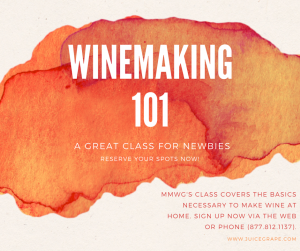




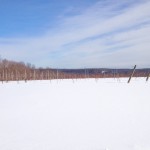

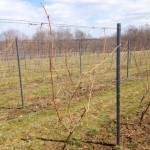

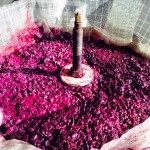






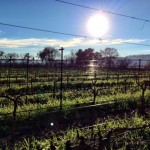
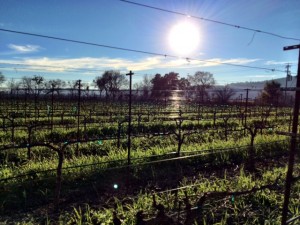

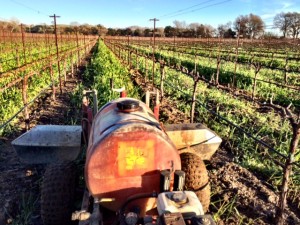
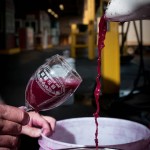
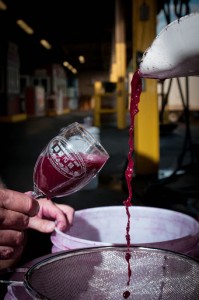
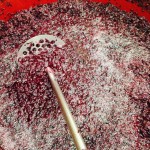


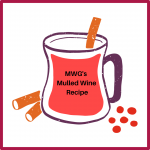
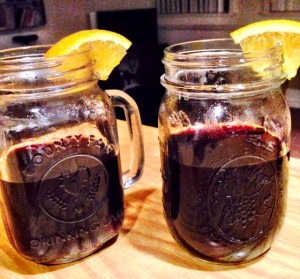
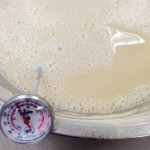




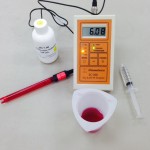
Recent Comments